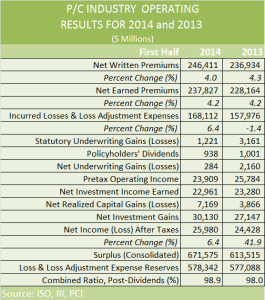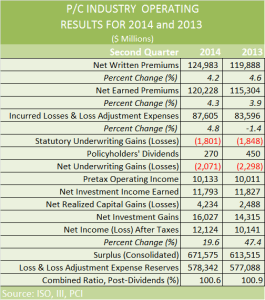The combined ratio for the property/casualty insurance industry became slightly worse in the first half of 2014, as net investment income declined and weak operating income continued. But net income rose a bit, thanks to a jump in realized capital gains, according to a new report from ISO, a Verisk Analytics business, and the Property Casualty Insurers Association of America (PCI).
Specifically, realized capital gains on investments for the industry hit $7.2 billion in the 2014 first half, up $3.3 billion over the same period a year ago. If you add net investment income to the equation, overall net investment gains reached $30.1 billion, 11 percent higher than the $27.1 billion achieved in the first six months of 2013. All of this helped net income after taxes reached $26 billion, up $1.6 billion from the $24.4 billion generated in the first six months of 2013.
Insiders are keeping a close watch on the p/c industry’s collective drop in net investment income, which hit $23 billion in the first half of 2014, down $300 million from $23.3 billion produced in the first-half of 2013. They’re also concerned about pretax operating income, which shrank to $23.9 billion in the first half of 2014, $1.9 billion lower than the same period in 2013. This drop, they said, stemmed from a $1.9 billion drop in net gains on underwriting, plus the declines in net investment and other income.
“While insurers’ net income rose modestly in first-half 2014, the deterioration in underwriting results and the drop in investment income both raise questions about the quality or sustainability of insurers’ earnings,” Michael Murray, ISO’s assistant vice president for financial analysis, said in a statement. “Other factors raising questions about the quality or sustainability of earnings include the extent to which underwriting results benefited from favorable reserve development and the extent to which insurers’ net income benefited from realized capital gains dependent on developments in financial markets.”
Murray added that insurers’ overall rate of return remained “subpar” versus long-term historical norms, and that insurers now need much better underwriting results to be as profitable as they were in the past.
For example, insurers reported a 7.8 percent annualized rate of return on average surplus for the first six months of 2014. That is down from the 9 percent average overall rate of return “for the 55 years from the start of ISO’s annual data in 1959 to 2013,” Murray said. That is the case, he noted, even though the 98.9 combined ratio for the first half of 2014 was 5 percentage points better than the 103.9 average combined ratio for the past 55 years.
As well, policyholders’ surplus soared to $671.6 billion as of June 30, 2014, up $18.2 billion from the $653.4 billion at the end of 2013. Policyholders’ surplus is now at a record high and bodes well for the industry, Robert Gordon, PCI senior vice president for policy development and research, said in a statement.
Below, we’ve listed numbers from the report in detail:
Source: ISO/Verisk/PCI























 A Practical Blueprint: The Five Plays of an Innovation Culture
A Practical Blueprint: The Five Plays of an Innovation Culture  How One MGU Grew Fivefold When Capacity Fled Cat-Prone Property Markets
How One MGU Grew Fivefold When Capacity Fled Cat-Prone Property Markets  Legal Finance and Insurance: From Confusion to Collaboration
Legal Finance and Insurance: From Confusion to Collaboration  Chubb, The Hartford, Liberty and Travelers Team Up on Surety Tech Co. Launch
Chubb, The Hartford, Liberty and Travelers Team Up on Surety Tech Co. Launch 



